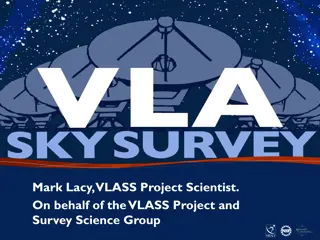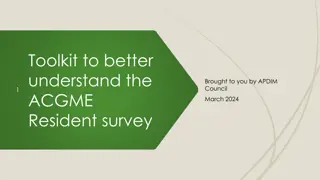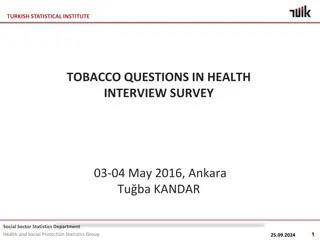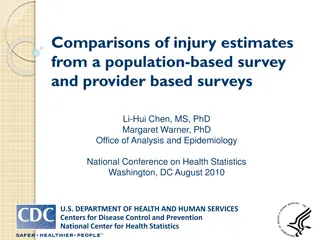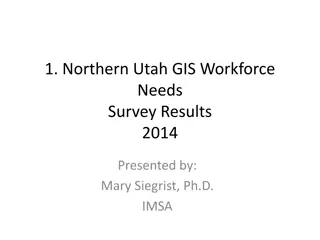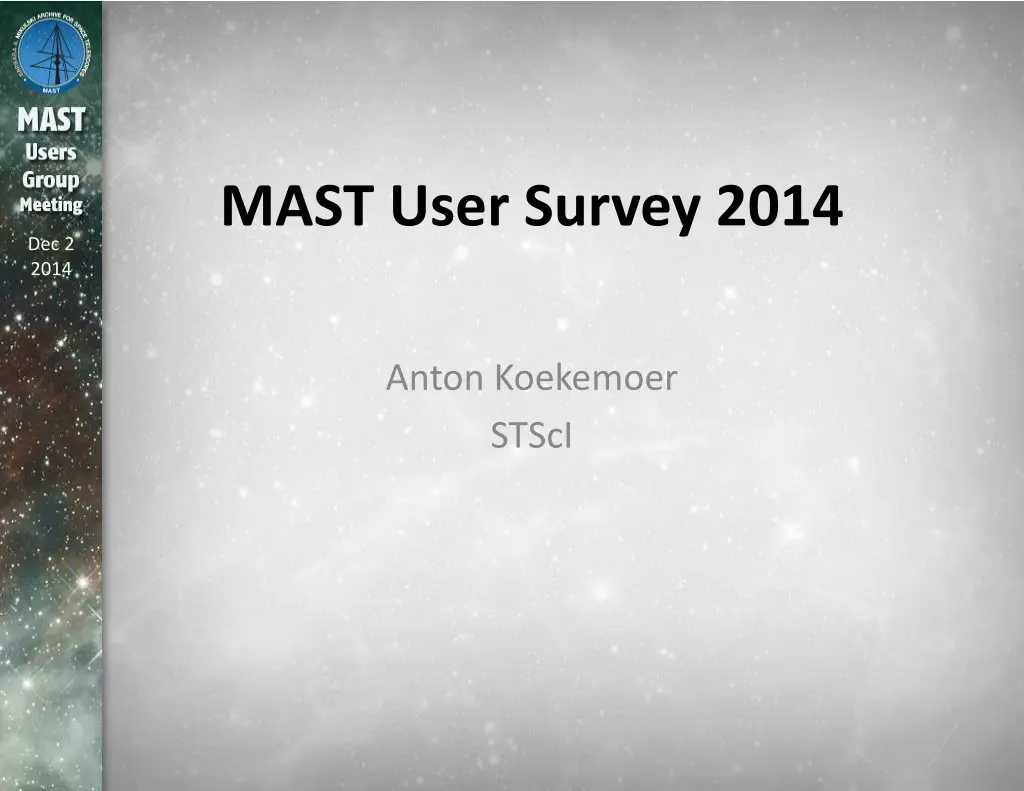
Insights from MAST User Survey 2014 - Usage, Missions, and Performance
Discover key findings from the MAST User Survey 2014, including usage patterns over 12 months, mission access preferences, and user feedback on data retrieval performance. Gain valuable insights into user behaviors and satisfaction with MAST services.
Download Presentation

Please find below an Image/Link to download the presentation.
The content on the website is provided AS IS for your information and personal use only. It may not be sold, licensed, or shared on other websites without obtaining consent from the author. If you encounter any issues during the download, it is possible that the publisher has removed the file from their server.
You are allowed to download the files provided on this website for personal or commercial use, subject to the condition that they are used lawfully. All files are the property of their respective owners.
The content on the website is provided AS IS for your information and personal use only. It may not be sold, licensed, or shared on other websites without obtaining consent from the author.
E N D
Presentation Transcript
MAST User Survey 2014 Dec 2 2014 Anton Koekemoer STScI
2014 continued new survey approach: Kept new structure, with distinct sections: Dec 2 2014 Continue improving targeting MAST users: 2012: sent to 8,410 emails, 301 responses (3.6%): all HST proposers, all archive accounts (too many inactive) 2013: sent to 3,079 emails, 180 responses (5.8%): all HST proposers in last 5 years, all active archive accounts 2014: sent to ~5,000 emails, 321 responses (6.4%): expanded HST email list, all active archive accounts Advertised survey by other non-email avenues: Facebook, Twitter, MAST pages, newsletter mailing
1. How often have you used MAST in the past 12 months? about half (53%) are quite active (ranging from daily to a few times / month) Dec 2 2014 321 responses 45% 43% 40% 36% 35% 30% 25% 20% 14% 15% 10% 5% 3% 3% 0% daily few times/ week few times / month few times / year never
2. Which missions or products did you access? 2014 Notes: HST percentage of users is somewhat up: (29% 36% from 2013 2014) Kepler % down but number of users remains similar: (55 50 users from 2013 2014) GALEX 15% HST 36% Dec 2 2014 DSS 9% IUE 5% HPOL 0% 2013 ORFEUS 1% Kepler 7% Copernicus 1% GALEX 13% FUSE 4% EUVE 1% HLA 8% HLSP 5% ASTRO 1% DSS 9% HST 29% Swift 1% VLAFIRST 2% GSC 1% IUE 6% XMM-OM 2% ORFEUS 1% If you selected 2 or more missions above, did you use them together in the same project? Yes: 134 (62%) No: 83 (38%) (c.f. 60% / 40% in 2013) Kepler 12% EUVE 1% FUSE 6% Copernicus 0% HLSP 5% HLA 6% VLAFIRST 2% Swift 3% GSC 3% ASTRO 1% XMM-OM 2%
3. If you retrieved data from MAST in the last 6 months, what did you think of the performance? 70 Very Responsive 60 Adequate Dec 2 2014 Unresponsive 50 % of responses 40 30 20 10 0 2012 2013 2014 Notes: some more calibrations were added this year with on-the-fly processing for ACS, WFC3 data; results this year were evenly split between adequate and very responsive.
Q3 comments / feedback received: a) With IUE, it seems that I cannot find anymore the date in a useful format (ASCII tables) b) The new search portal for MAST considerably increased the effort to search for data in the archive. The JavaScript performance is just not good enough. In some cases, the MAST portal is far too slow and needs too long to adjust the filter. It is annoying that one has too wait until changes to a certain filter are applied before one can adjust the next filter. Furthermore, the distance selection appears at the end of the left side bar, although it is one of the most important search criteria. Apart from that, the standard search radius (if it is not directly specified at the start of the search) is far too large and thus unnecessarily increasing the number of results. The old version was possibly not as powerful as the new one, but it was more convenient to use. Dec 2 2014 For the HST archive, it would be incredibly useful to know if an RA, DEC is actually in the image. Galex never seems to give me the right target. APT+Alladin do a much better job I access MAST data using SkyView for converting to different map projections. However SkyView is not updated with GR7 only 6. I wish your website had tools for converting to different projection types or had listing of methods or other website locations other than SkyView that do this. I have no idea when SkyView will be updated. I found the system very confusing to use. It was especially hard to track down specific objects, especially if the coordinates are slightly different between different programs. I use the HST services. I wish I could get an estimate of how long a request would take to execute *before* submitting the request, taking into account the files requested, the average on-the-fly processing needed and what's already in the queue. Even providing data on the wait time as a function of time of day (for example) might be useful to time requests better. Furthermore such information might curb frivolous requests. Also, having files gzipped by default would be great. It is always difficult to choose software, then teach one's self how to use it for a specific objective. The archive might consider creating or refining a list of software, what it is intended for, and that would allow for easier location of tutorials. I was only working with specific HST images. I wanted to plot the positions of 'objects' so that I could compare them with other studies of the same system. Also, with HST studies, often the images have brighter objects subtracted. Understanding what was done to subtract an object would make it easier to tell if one is working with valid data, or photographic artifacts left over by the subtraction. My results were inconclusive. I am an infrequent user and I may be ignorant of what is available. My experience was good, but when I showed my results to the person primarily responsible for requesting the HST study I received 'Bad Data' as an answer. I could not respond to that statement, and had no choice but to say 'Thank You' and accept it. If, with HST, there were problems with the study, that should be noted clearly along with the images.
Q3 comments / feedback received (cont'd): It is difficult to know which high level products to use... For example in the case of HST you provide the DADS or HLA versions. Not all the data are available in the HLA or DADS... so I have to decide what version to use on a file by file basis, which is very inconvenient... It also means I have to read the documentation for the 2 pipelines... It seems now it is impossible to select specific file extensions, which is really really unfortunate. For instance, sometimes the flc files for ACS are not directly available, and I am forced to download all files in order to have what I need. But by far the most important complaint I have to make is the fact that it is not possible to download single files. This dataset format is really annoying. Dec 2 2014 It would be nice if it were a little easier to do searches on moving targets. Right now, as far as I understand it, I have to query for *all* moving targets, wait for a long time for the query to run, and only then can I limit the results for whatever planet etc. I'm interested in. (But perhaps I just don't know how to use the interface correctly; I don't use it very frequently.) My problem is that it I like the MAST Portal as against Classic MAST for data browsing, but the downloading options are not obvious on MAST portal. Furthermore, when I add the data to basket, I get access to _drz files whereas I would want to get c0m files to reprocess. Some files are available in 'DADS' format for retrieval, not 'FITS'. This is confusing. Specially with HST instruments, the search engine doesn't understand well whether the field-of-view covers the requested coordinates or not. The interface is a bit opaque, and I wish I could have selected on more header parameters, e.g., exposure time, dither pattern. The quicklook feature for Kepler light curves does not work well with all browsers. The search interface is not ideal to retrieve data, for instance we never know a priori the target name chosen by the PI. This criterion shall be standardized to usual/larger target names. Else, I have had some difficulties to retrieve data by name of PI, selection of instrument or number of program. The software which calculates if an object is in the FOV of a given instrument does not know the shape of the field of view of that instrument. The new interface does not allow plotting This new MAST Portal is sluggish. The old HTML table were much faster. Also, retrieving normal XY ASCII tables of calibrated spectra has become more difficult/impossible.
4. Which activities do you use MAST for? 2014 300 Primary Dec 2 2014 250 Secondary number of responses Minor 200 150 100 50 0 Research Obs. Support Education Outreach Amateurs
4. Which activities do you use MAST for? (2013) (somewhat more usage for research in 2014) 2013 160 Primary Dec 2 2014 140 Secondary 120 number of responses Minor 100 80 60 40 20 0 Research Obs. Support Education Outreach Amateurs
Q4 comments / feedback received: Wait times for data to be deposited on the server are rather unpredictable. I have experienced anything from a few minutes to half a day. It would be nice to have some kind of estimate, even a rough one, to know if you need to go get a cup of coffee or just wait for the next day to get started. I mainly work with WFC3 data. I wonder what happened to the option to retrieve only RAW or only FLT files? With the recent change in the 'Retrieval Options' page I am now forced to request ALL data for a given dataset which slows down my requests and puts unnecessary burden on your server. Dec 2 2014 I access MAST data using SkyView for converting to different map projections. However SkyView is not updated with GR7 only 6. I wish your website had tools for converting to different projection types or had listing of methods or other website locations other than SkyView that do this. I have no idea when SkyView will be updated. I like to assign new graduate students and senior undergrads a project using the HST archive to learn the basics of manipulating astronomical images. It would be very helpful if there were a way to know what the individual exposures are in the archive, not just the total exposure time in a given filter on a given target, etc. That's how it used to be. The new system, with multiple exposures rolled together into one line represents a significant loss of useful information. More flexible tools for the education/outreach community would really go a long way in getting authentic data to the public. an archive of ppt presentations suitable for public talks would be very helpful for outreach purposes; otherwise, the Hubble Heritage collection is good starting point Provide as much as possible fully reduced data. This will increase the useability of the data
5. Which MAST interfaces do you commonly use? Notes: Classic MAST is still the most frequently used MAST Portal usage has increased (and the combined Portal+HLA usage is about the same as classic MAST) Dec 2 2014 2014 250 Classic MAST MAST Portal HLA GalexView Scripted Access CASjobs Starview All 200 number of responses 150 100 50 0 Browsing Retrieving Obs. proposals
Q5 comments / feedback received: Why is the Portal different from the HLA? Wouldn't it be better if they are the same interface seeing that they mostly have the same function - search, visualization and retrieval of data? Dec 2 2014 I use MAST access through Aladin I use SkyView but they are not updating yet with GALEX GR 7 so looking for alternates that can convert to different projection types like 'Rectangular (Car)' I am an infrequent user. I'm not sure what interfaces I used. I will use MAST in the future, and participate in future surveys to provide better input about my experiences. Pretty pictures for presentations and papers Retrieving metadata on observations Search for interesting science cases
6. MAST has raw data from the GALEX CAUSE mission (a period of time when GALEX was operated by CalTech, and during which it extended the AIS to lower galactic latitudes and observed areas of the sky such as Kepler and the Magellanic Clouds following PI- led projects). Only a subset of the data was processed through the GALEX pipeline, and much of that data is of poorer quality than GR6/7 data collected with standard observing modes. Dec 2 2014 Question: If MAST provided the *raw* GALEX data files, would you use these data products to perform your own calibration of the data for science purposes? Would you realistically consider undertaking such a project if the data were made available? Yes, I would definitely undertake such a project: No immediate plans, but a realistic chance that I would: 68 (22.1%) No plans to undertake such a project, likely also not in future: 225 (73.3%) 14 (4.6%)
Q6 comments / feedback received: I would be glad to look at any data as long as I have the appropriate viewing software with the documentation to learn to use it on my own. Yes, make it available. I would have no plans to undertake this project but would be interested in seeing results if someone else did it. Dec 2 2014 If funds were available, I would happily do such a project. Otherwise, I'd be very happy to rely on other people to this calibration. It will be a great service to the community if you can do that. Otherwise many people will do the same work, with a large range of quality of the data analysis It would be too difficult to set-up the calibrations My science relies on the available GALEX FUV data, so GALEX CAUSE is not of immediate interest to me. Please provide correctly calibrated data in an accessible form (FITS tables, ASCII tables). This is a very good idea... What fraction of the scientific community can pretend to be able to perform such a calibration? the instrument team only... These datasets are extremely interesting! please provide the processed data for the entire CAUSE mission!
7. The Kepler K2 project has plans to provide extracted lightcurves starting with Campaign 3. Question: How much would the absence of such data products for Campaigns 0-2 affect your ability to conduct your research? Dec 2 2014 Would not significantly affect my research, since I make my own extracted lightcurves or have the ability to easily do so. 11 (3.7%) Somewhat affects my ability to conduct research, but I can extract my own K2 lightcurves with a moderate amount of effort. 26 (8.6%) Significantly affects my ability to conduct research since I do not have the resources to extract my own K2 lightcurves. 42 (13.9%) I don't use K2 data. 223 (73.8%)
Q7 comments / feedback received: I've used Kepler data in the past and if I was to take it up again I would probably find it useful to have light curves extracted. Might I suggest both extracted and extracted data be made available, clearly documented. I have no way to even guess what my future needs might involve. Dec 2 2014 Currently, there are professional scientists extracting their own lightcurves from the K2 TPFs. Could MAST contact these people to inquire about potential access to their data? The data could be archived temporarily on MAST until the K2 project releases their official dataset next spring. I am anxiously waiting for someone to provide K2 lightcurves so that I can use it with my software system called LcTools. I have a large number of customers that wish to access the data for research purposes. Actually, in between 'somewhat' and 'significant.' I can make my own lightcurves, but those have better quality than the standard lihgt curve provided by the project (i.e., Kepler). However, because they are better, they take significant resources (time and money), of which I have neither. So the availability of 'standard' lightcurves would allow me to fairly quickly search through the data sets and see which LCs to concentrate on. NOTE, I will have of order 4,000 targets in K2/C3 (like for K2/C1), so such a quick look ability would significantly help me out. NOTE that is about 25% of all targets: I am a big customer (or at least could be). Providing the highest quality fully reduced data should be the main goal of MAST, and will provide a great service to the community. There are always a few who love reducing data themself, but the vast majority would like to put their efforts mostly at higher level data analysis.
8. Related to Question 7, how would the absence of the MAST- produced K2 light curve "previews" affect your use of the MAST archives? Dec 2 2014 Would not significantly affect my use of the MAST archives, I hardly look at preview plots anyway. 21 (7.0%) This will somewhat affect my use of the MAST archives, they are useful but not essential for deciding which data products I want. 32 (10.7%) This will substantially affect my use of the MAST archives, since I find the preview plots useful for deciding which data sets to retrieve. 27 (9.0%) I don't use K2 data. 219 (73.3%)
Q8 comments / feedback received: Would like more information about saturation in the flags for extracted lightcurves The nature of this question implies a subtlety I'm not catching! I never look at preview plots, but do data retrievals often, and thought the latter correspond to using the MAST archive. Dec 2 2014 I PREFER to extract light curves from RAW data, myself. I don't currently use MAST for Kepler data, but I envision this changing in the future. I do not work with this data often, and I chose button 3 because I look at everything involved with a study. I do frequently look at preview plots for other missions, however If those previews would be available for download in such a way that I can quickly browse through them (say 5 or 10 seconds per source) then I could preview my whole target list in a day of work, more or less.. So that would be very helpful. I emphasize: being able to download all previews. Typically, it is WAY too much work of going through a browser and having to click on all those target and generate a preview, etc. A preliminary quick-view is useful. But the bulk of work lies in detailed follow-up analysis which, cannot really be expected beforehand.
9. Are there any metadata (columns) missing from the K2 ("EPIC") target catalog that would facilitate your research? To facilitate my research I would need raw images with flagged empty pixels. Not too difficult, but they are not available. And this is Annoying. Dec 2 2014 glon, glat Additional metadata information from MAST should be treated with caution. It is quasi-useful, but only as counterpoint to separate research. The 'galaxy' information is really poor. I spend a considerable amount of time collecting galaxy data from a variety of other catalogs that are not so star-centric. It would help, if such info were available in EPIC. However, I can collect that info in about one day per K2 campaign. Then again, it seems that the K2 people only select objects with EPIC numbers, so a large farction of interesing sources (big-ish galaxies) are not potential targets.If larger tables would be retrieved, it would be so useful. In selecting parameters in MAST portal, no '>=' or '<=' are allowed. Include them will be a nice improve.
10. Are there any metadata (columns) in the K2 ("EPIC") search that should be in the Kepler Target Catalog search but are not there? VERY IMPORTANT, but not for EPIC It is my experience that the world coordinates as stored in the FITS headers of the target pixel files are quite far off from the coordinates of the EPIC source that is supposed to be in these particular target pixel files. I have overlaid the EPIC catalog on the images from the target pixel files, using the world coordinates from the FITS headers, and typically, there is NO source close to the center of the map (where the FITS header says it is pointed at). I can often, but not always, find a shift from the FITS world coordinates to the locations of the EPIC sources. All of this is quite annoying: that my sources are at an a-priori unknown locations within the images as downloaded from MAST (and Kepler, I presume). Dec 2 2014 Additional metadata information from MAST should be treated with caution. It is quasi-useful, but only as counterpoint to separate research.
11. Please rate the usefulness of these HLA tools (sorted according to responses) Advanced search options Dec 2 2014 Image previews and cutouts Footprint view of data on sky Inventory table sorting & column filtering Interactive display view Uploading a list of positions to search Downloading data via a cart Very useful Somewhat useful Unsure Not useful External catalogs & HLA Source overlays Help Center 0 20 40 60 80 100 120 number of responses
12. Please rate the usefulness of the following HLA data products (sorted according to responses) High Level Science Products (Level 5) Dec 2 2014 Combined images (Level 2) Mosaic images (Level 3) Source lists/Catalogs Spectra Color images (Level 4) Very useful Somewhat useful Unsure Not useful DADS Retrievals Other associated files 0 20 40 60 80 100 120 number of responses
Q11,12 comments / feedback received: HLA is exceptionally useful for proposal planning, since it provides a way to quickly view data. However, it's important to get all the data ingested such that they can be directly downloaded, rather than having to use DADS. DADS ends up being a bottleneck during proposal times (especially if you have to stage the data) since the archive is seeing heavier use. What I really find useful are the reprocessed images with updated WCS information. Dec 2 2014 The interactive display view is awesome!! Table sorting and column filtering is very useful, particularly for fields with tons of data, but it's a bit difficult to figure out how to filter the data. It would be awesome if there would be automatically generated drizzled tiny tim PSFs for the Level 2 and Level 3 images. I use the Level 1 images sometimes, too. I tried to zip the files, but the file became too big to ever get transferred. It would be smart if HLA made a few smaller zip files instead of then either forcing me to download sequentially or redo a search with several sets of data. I miss a document describing concisely the processing of the data. When was the data processed? what version of the pipeline was used? what steps were involved? Is the astrometry calibrated? Maybe it exists already but I could not find it... I download large batches of data for which HLA is not useful. It is much more efficient to stage through MAST. Making footprints only available for download would be an invaluable product. The current solution of running footprintfinder locally is not efficient. Full documentation on the processing would be appreciated and very helpful for my use of the data products :-)!
13a. Hubble Source Catalog: How frequently do you think you would use the HSC for your research? 2014: 265 responses Dec 2 2014 Moderately 44% 2013: 138 responses Extensively 9% Moderately 40% None 19% Extensively 11% Rarely 28% None 17% Rarely 32%
13b. Hubble Source Catalog: What modes might you want to use in interacting with this catalog? 2014: 290 responses Dec 2 2014 Cone Search 55% 2013: 179 responses Other 1% Cone Search 45% Casjobs/SQL 14% Download full catalog 30% Casjobs/SQ L 29% Other 2% Download full catalog 24%
Q13 comments / feedback received: having catalogs and photometry for all/any bands, not just the most commonly used ones, would be useful to my research. Can I search for solar system (moving) objects? Please make sure TOPCAT can see this database. providing improved photometry for objects visited multiple times in the same filter by different programs, providing time domain data for objects visited multiple times. Python API would be immensely useful! This could be an immensely useful tool, if it's well executed. Master catalogs are awesome. For example I've found the 3D-HST catalog from Skelton et al to be very useful for my research recently. Including temporal information (when available) would be helpful. Without knowing the science pedigree of the catalog, it is hard to tell if the catalog would be useful. Are there plans to integrate high level catalogs contributed from large surveys (such as CANDELS) in the HSC? It would be fantastic if these catalogs can be cross tied to all the data available for them in the archive. This kind of product will become more and more useful in the future as one would like to see if a (large number of) sources has been observed before by HST. For example, for astrometric purposes (long time baseline) or for follow up (with JWST, ...). For a single object it is possible to do so by hand, but if one is interested in a specific class of objects (may 100s or 1000s known), then one typically does not care about the individual source. Instead, one would want those source that have HST observations with property A, B, C, .. or a combination. That can only be done efficiently with such as catalog. Dec 2 2014
14. Tried the MAST Portal? Yes: 78 No: 227 Please rate the usefulness of these current features: (sorted according to responses) Dec 2 2014 Search all MAST missions by position Cross-match list of positions with all MAST missions Filtering of result data sets Cross-match list of positions with CDS catalogs (e.g., SDSS, Column manipulation: sorting, order, visibility Sky view with observation footprint and catalog overlays Export of result data sets to tabular formats (csv, VO Table, etc) Search Virtual Observatory image and catalog collections by Import of data sets from tabular formats (csv, VO Table, etc) Very useful Somewhat useful Could not find Not useful Downloading data via a basket Selection of observations in both Grid and Sky view Scatter plots of result data sets 0 20 40 60 80 100 120 number of responses
14. MAST Portal: What additional features would you find useful for the MAST Data Discovery Portal? An educator's version of the portal with search capability honed down to the essentials of what a high school classroom would use - with analysis tools. Download ds9 region files or footprint polygons in some machine readable format for a fov search downloading in batch mode, as in CasJobs. easy download of raw data in an intelligible format Here is a use case I've encountered several times. I would look for all ACS and WFC3 grism observations in the GOODS-S field. Searching the Portal at the position of GOODS-S is overwhelming and has crashed my browser several time because there are over 10,000 datasets. I wish I could do a pre-filter such as 'show me only HST hits with these WFC3 filters' or at least to have some such options in the 'select collection' menu. - I wish the portal wouldn't hide filters that have long lists of values: when a filter has more than 100 values it is especially useful to be able to filter the results. I also wish that all filters are displayed by default or that the browser would cache the user selections, rather than having to go through the 'edit facets...' menu after every search. - I think it would be very useful to be able to download regions files for the selected datasets to allow users to create visuals similar to the AstroView in ds9. Also, it would be useful to be able to pull more data from the headers of the images: PA is an obvious parameter that is currently not available through any of the tables. - I don't see the point of the basket and downloads - there are limited options for download and it mirrors the interface already available through the search. Maybe I am missing some key differences? I did not pursue using the portal as I did not find it fast to figure out if there was Xray data and HST data on the same field and then download the data. I didn't know it, but I tried now. Fantastic tool! Perhaps some ground observatories could be added. I think it failed or I failed on solar system targets I usually search for HST data by PI name or most often, Program ID. Since I cannot figure out how to this with the new Portal, I never go there. I've found it slow to load and therefore am not highly motivated to use it. Dec 2 2014
14. MAST Portal: What additional features would you find useful for the MAST Data Discovery Portal? (cont'd) It would be awesome to be able to switch between images from different missions, matched to the same coordinates. For example toggling from images of the same patch of sky taken by HST, GALEX, DSS, etc. Are Herschel data included? I didn't notice any, but Herschel photometry would be good to have. It would be extremely useful to have advanced data plotting and data visual tools available through the portal. It would be great if there could be a limit of the returned matches. Searching the GOODS-S region killed my browser. I wish the 'Select Collection' menu allowed users to limit searches to a single mission. Thank you for changing the filters such that grism data now appears under 'spectra'. Like all previous MAST search engines, the ability to find planetary observations is totally inadequate. Target names such as 'Jupiter' can not be resolved, and planets do not remain at a fixed RA/Dec. More robust, interactive data plotting/visualization. The ability to filter not just by mission but by filter/wavelength within a mission. For example, it would be nice to request HST data with the F814W filter. The download basket providing access to, in case of HST data, the calibrated basic data (c0m files) instead of drizzled files (drz). or at least both. use of color Using the MAST Portal I could not access all the data I used to download by the classic MAST. Specifically I tried to get HST cal and drz and NICMOS cal and ima fits files. I compared the accessible data from MAST Portal with all available data for one specific object downloaded months ago. In extreme cases there is only one a *TOTAL.fits or one drz.fits file downloadable although I know for sure that there should be many single exposure fits and several drz files. And it's not because of the 'recommended data only' checkbox. This has now not necessarily something to do with Portal frontend itself, whose new features make my work much easier, but it seems to me as if somewhere a selection / filtering was made for me. If so it should be removed. Thanks in advance. was very slow when I tried it, so haven't really given it a proper test drive Dec 2 2014
15. How important are the following planned features in terms of being useful for your own work? (sorted according to responses) Increased integration with publications (ADS) Dec 2 2014 One-click access to data from your own proposals Scripted access to all MAST data Custom image cutouts Improved interactive viewers: imaging & mosaics, User accounts with persistent custom settings Upload of larger input files for cross-matching Improved capabilities for finding variable objects Very useful Export data to cloud (e.g., Dropbox, other) Somewhat useful Unsure Improved search for moving targets Not useful Mobile access 0 20 40 60 80 100 120 140 160 number of responses
Q15 comments / feedback received: This is a spectacular list! Better custom cutouts (whether via a URL-based fitscut approach or something new) would (continue to) be extremely useful. Scripted access in general would be powerful. the above 'Improved interactive viewers: imaging & mosaics, spectra, light-curve viewer for Kepler' was too vague. It would be very useful to download Kepler raw images in fits format with flags (easy to compress) in the empty pixels. This should also not be difficult or complicated to do. ... and should have been done in the first place, as the default option. Sometimes my browser or computer needs to be restarted and I lose my current search. It would be great to have a search history available in the user account along with persistent settings. persistent custom settings would speed up access a lot! It's already a great tool! I strongly support your efforts Looking forward to see these improvements implemented In case of HST data, particularly imaging, I think it is perfectly possible to include all images ever taken in a reduced form. Although reduction for most purposes is straightforward, this capability would certainly save time. Good facility for plotting of results, interactive visualization is very important to make the portal most useful. Generally unfamiliar with these, and generally not interested. Full information on every individual exposure would be very useful (and used to be available). Rolling multiple exposures into one line that tallies the total exposure time is not nearly as informative. +1000 improved search for moving targets. Dec 2 2014
Q16. How can we do a better job of supporting your archive needs? Please suggest other new features or improvements you would like to see. a) offer convenient data products from IUE (e.g. high-resolution spectra as re-binned contiguopus tables) b) offer reasonable data products (not raw data) from FUSE Dec 2 2014 I am looking for reprojection methods for GALEX Imagery and Data. SkyView is not updated with latest GR7 so looking for alternatives. I wish MAST had their own tools for this on their website. I principally use the classic MAST interface, but I regularly go to the CADC HST archive instead, for two reasons: 1. I can download the data instantly, without needing to wait for OTFR 2. I can enter coordinates for a particular object, and get all HST images that include that point anywhere in their field of view If the MAST interface could adopt those two features then it would be much improved in my estimation. A much more minor concern: I have found that afer some searches I am unable to select just the flt/flc files for download from MAST, so I end up getting many drz images delivered to the staging area, which I then ignore. Hard, source or original data should be distinct. Where there is data that has involved some degree of additional processing, it could be a little bit clearer what, where and how. Some such processes may be quite normal and standard (e.g. cosmic ray strike removal). Others, e.g. related to possible source confusion, could involve less standard or well-known methods. If here is additional information on targets (e.g. stellar masses), it should be clear where it comes from. Better quality drizzled products... e.g. revised/improved defaults especially for canned patterns, more HLSPs, or else products per proposal and not per visit. It seems that most users are not redrizzling their data so it would be good if more effort could be put into improving the archival products. In my opinion, MAST has done a good job over the years in steadily improving its services. Some of the changes are obvious to the users (e.g., interfaces) while others are hidden, but no less valuable (e.g., speeding up OTF processing requests).
Q16. How can we do a better job of supporting your archive needs? (cont'd) Apparent magnitudes of selected objects / central object, redshifts if available or dust extinctions would make many lives much easier (or even just a link to the NED calculator filling in the coordinates)... is there actually an automatic pipeline for that like the terapix project for CFHTLS data? Also having a download option for PSFs would be great, e.g. a PSF extractor. Since I don't know where else to add this comment, I just do it right here: This has again nothing to do with the portal or other - very much appreciated - services stsci provides, but it is something that I noticed several times while working with HST-WFPC2/-WFC/-NICMOS data: 1) there are sometimes TOTAL and drz and drz_1 files as recommended products available and there is no obvious difference between the three and the previous steps in the pipeline are for some reason not retrievable via the portal. 2) many headers don't contain enough information. For example it happened to me that equally labeled combined drz files with just the same HISTORY in the header where combined in two different ways, one by averaging, one by summing up. The EXPTIME however had the same value, which checking the fluxes could just not be right. Maybe this is me not being able to read the fits headers properly, but on the other hand there is not much one can do wrong. Many programs just read out the EXPTIME value from the header relying on its correctness. Ones it happened to me that EXPTIME was missing in the fits header but luckily it was mentioned in one of the columns in the MAST Table View. I wonder how something like that can happen. But I look at the bright side: this is a case where the MAST Portal was very useful. 3) I realised that for some files the plate scale entries are just gone if the fits file is rotated so that North is up, i.e. CD1_2=0. 4) Why do many drz files still contain Cosmic Rays. It would have been so easy to get rid of those in the combination procedure using a CR veto. But in cases where no single exposure files are retrievable (see point 1) I have no other choice but to take LA.Cosmics to remove them, which isn't always doing a good job. 5) Photfnu (or Photflam and Photplam) is missing for some data. In view of all the inconsistencies in the headers, isn't there a way to just check for their completeness by means of a filter checkbox ... like: if something's missing don't even show it to me. 6) I could swear that there have been HLSPs for some of the galaxies I study, but know they vanished from the database. But I don't have any real proof for that. Ok, so much for now. Thank you so much for making this survey and thank you in advance for giving me feedback on the points above. If the above comments don't fall in your field of expertise, please feel free to forward all my comments to whom it may concern. Dec 2 2014
Q16. How can we do a better job of supporting your archive needs? (cont'd) Improving the archive data processing to have good astrometry would be infinitely useful. Adding documentation for the HLA data products would also be helpful. Full integration of HLA + MAST + High Level Science Products would also be useful -- thus far I have had to do searches individually on the three databases to find what I need. Tie ins to Virtual Observatory Holdings could also be of use. Otherwise, this is a fantastic service. Thank you so much for it! Dec 2 2014 It is confusing having three entry points into the Hubble data archives: the standard MAST search form, the MAST Portal, and the HLA (and perhaps there are more I do not know about). Why is there a duplication of effort between developing the HLA and the Portal? Where should a user look to look to start their search? I'm at the Institute and I don't know the answer to these questions, so there may be people in the outside world wondering too... It would be awesome if there was a script to automatically generate drizzled tinytim PSFs for level 2 and level 3 images. I've tried to do it manually using tiny tim a couple of times but always failed miserably. But this should be an obvious scriptable thing, as all the exposure and drizzling information is also used to make the level 2 product. My needs would be better served if the ESA HST archive model was adopted to replace the classic MAST front end. It is by far the most user friendly way to access HST data. I particularly hate that individual flt files are not listed in the MAST archive and that everything is served up as an association. This really limits the use of the MAST archive. My work focuses on resolved stellar populations. Most of my use of the archive would be matching observed sources within a field to each other to create spectral energy distributions, or looking for the brightest sources at particular wavelengths. An ability to cross-correlate my own data to that observed in large-scale missions (as VizieR does) would be the most important thing I would need. I was unaware of a lot of the tools you seem to have made available here. You seem to have got quite a lot of this under control already, so I clearly need to do some exploring. Keep up the good work! Overlay NED objects.
Q16. How can we do a better job of supporting your archive needs? (cont'd) Providing and enhancing all web-service based access to data (querying and downloading) would greatly help me. Right now, some kind of access to the K2 lightcurves. Very important! Also, in order for my software system to support the official K2 lightcurves early next year, I would like to receive the 'wget' format and data directory naming structure. Dec 2 2014 Scripting through Python I think will be very useful. Please do not use IDL to scripting, because not all of us have a license. selection of objects by type would be very good ;e.g. all CVs observed by FOS in RA range a to b would be very nice to have. Support seems excellent. Thanks and greatly appreciated. Target name wild card searches. Better generic searches (I do this for PSF stars). the above 'Improved interactive viewers: imaging & mosaics, spectra, light-curve viewer for Kepler' was too vague. It would be very useful to download Kepler raw images in fits format with flags (easy to compress) in the empty pixels. This should also not be difficult or complicated to do. ... and should have been done in the first place, as the default option. The archive has been entirely sufficient for my uses but I tend to perform single object searches so the returned data are minimal enough to sort through manually. I am quite satisfied with the current format and options that the database offers. The archive has worked well for a long time now, keep it up.
Q16. How can we do a better job of supporting your archive needs? (cont'd) The classic MAST page is in desperate need of an update: Downloading proprietary HST data is much more awkward then it should be. There should be a proper login associated with user accounts with a way to see all your proposal's data. Right now it's very difficult to figure out anything about login accounts and the like. I do very much like the idea of that account being tied to user settings (among your list of future plans), so I do hope you end up implementing that. Another item: right now there seem to be a lot of ways to do the same thing. E.g., the MAST portal and HLA have very similar visual interfaces to search and view pointings around an object or coordinates. Somewhere very prominently, there should be a clear explanation of how these are different and which is best for various tasks. Right now I tend to use HLA because it's the easiest to start with, but I really have no idea what I may be missing by not using MAST (portal or classic) or something else. Dec 2 2014 the ftp server has got to be replaced with something less antiquated. Actually downloading the data once its been staged is not the best process right now. Id like to be able to download a tar ball straight from a link. The only trouble I've had was identifying targets within the same proposal (when many have been found my search), but I realized this was only user-error. You guys are already doing a great job! You guys are already pretty awesome. NOTE: All the full survey results are maintained by MAST staff at STScI.






